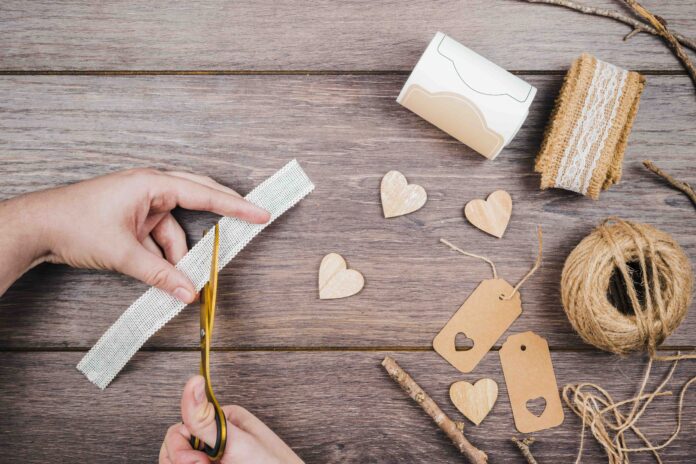Table of Contents
The Art of Crafting: A Growing Trend
Crafting is the art of making something by hand, with or without the use of machinery. It is an activity that has been around for centuries, and its popularity only continues to grow. With the increasing awareness of mental health and wellness, crafting has become a therapeutic practice for many individuals.
It allows people to express their creativity, reduce stress and anxiety levels, and even boost self-esteem. The beauty of crafting is that it encompasses a vast variety of activities, from knitting to woodworking to painting.
This means that there is something for everyone to enjoy and create. Furthermore, crafting can also be a social activity where like-minded individuals can come together to share ideas, tips and tricks.
The Importance of Having the Right Tools
One crucial aspect of crafting that cannot be overlooked is having the right tools. Just like any other job or hobby, having the correct equipment can make all the difference in producing high-quality work. The right tools will not only make your creations look more professional but will also save you time in completing your projects.
Having inadequate tools will often result in frustration or even cause injury when using them incorrectly. Moreover, inferior instruments tend to produce substandard results which can lower morale quickly.
It’s essential to choose quality over quantity when selecting your crafting equipment. Investing in high-quality tools will ensure that they last longer and perform better than cheap alternatives.
Basic Tools for Every Crafter
Scissors: Types and Uses
When it comes to crafting, scissors are one of the most essential tools you’ll need. There are different types of scissors, each with its own specific purpose. The most common type of scissors is the standard household scissor, which is perfect for cutting paper and thin fabrics.
If you’re looking to cut thicker materials like leather or felt, then a pair of heavy-duty scissors is what you’ll need. These scissors have a serrated edge that allows them to easily cut through tough materials.
For those who want precise cuts on delicate fabrics like silk or satin, then a pair of embroidery scissors is what they need. These tiny scissors have pointed blades that make it easy to trim threads or make small cuts.
Cutting Mat: Why It’s Important and How to Choose One
A cutting mat is an essential tool for any crafter who wants to protect their work surface while also ensuring accurate cuts. A good quality mat will not only protect your work surface but also prevent your blades from dulling quickly. When choosing a cutting mat, consider the size that will best suit your needs.
A larger mat will provide ample space for larger projects but may be cumbersome if you don’t have enough workspace in your crafting area. A smaller mat may be more practical if you have limited space but won’t be suitable for larger projects.
Another factor to consider when choosing a cutting mat is the material it’s made from. Self-healing mats made from PVC or polypropylene are durable and long-lasting, while those made from softer materials like vinyl may not last as long but can still get the job done.
Ruler: Different Types and How to Use Them Effectively
A ruler might seem like a simple tool, but it’s one of the most important tools in a crafter’s arsenal. There are several types of rulers, each with its own specific use. A standard ruler is great for measuring straight lines or basic shapes.
However, if you need to measure curves or angles, then a flexible curve ruler might be more suitable. For those who want to create accurate quilting blocks or patterns, a quilting ruler is what they’ll need.
These rulers are usually square and have grid markings that make it easy to measure precise shapes. When using a ruler, it’s important to position it correctly and hold it firmly in place so that your measurements are accurate.
It’s also helpful to mark your measurements with a pencil or marker so that you can easily reference them while working. By having the right scissors, cutting mat, and ruler at hand, any crafter can get started on their next project with ease and confidence.
Essential Tools for Specific Crafts
Knitting Needles: Types, Sizes, and Materials
If you’re interested in knitting, it’s important to have the right needles for your project. First, let’s talk about types of knitting needles.
There are two main types: straight and circular. Straight needles are single-pointed and used for flat knitting projects, while circular needles consist of two pointed ends connected by a flexible cable and used for both flat and circular projects.
When it comes to sizes of knitting needles, they’re measured in millimeters or US sizes. The size you need depends on the yarn weight you’re using, as well as the pattern.
Generally, the thicker the yarn, the larger the needle size should be. Materials matter when it comes to knitting needles.
Common materials include aluminum, plastic, bamboo or wood – each with its own benefits and drawbacks. Aluminum is durable but can be slippery while wood offers more grip but may not be as durable.
Crochet Hooks: Sizes, Shapes and Materials
Crochet hooks come in different sizes which are marked either with a letter or number (US) depending on where you live. A hook’s size determines how tight or loose your stitches will be and which yarns work best with that hook size. Just like with knitting needles there are different materials to choose from when selecting crochet hooks such as plastic hooks which are inexpensive but have less grip than aluminium hooks.
Steel hooks come in different sizes from fine lace weight yarn up to worsted weight yarn. The shape of a crochet hook also plays an important role in how comfortable it is for use over long periods of time especially if you have arthritis or similar conditions.
Sewing Machine: Features to Consider When Buying One
When buying a sewing machine there are several features that can make sewing easier and more enjoyable. Firstly, consider the stitch options available on the machine – some have only basic stitches while others have a wider range including decorative stitches.
Another important factor is the machine’s speed control and noise level. Some machines offer variable speed controls that allow for greater precision in sewing and lower noise levels can make sewing less disruptive to those around you.
It’s also worth considering features such as automatic needle threading, drop-in bobbin loading, and adjustable presser foot pressure which can all make sewing easier and more efficient. Don’t forget about portability; if you plan on taking your machine to classes or events, a lightweight model may be ideal.
Specialty Tools for Niche Crafts
Quilting Rulers: Different Shapes and Sizes for Precise Cuts
If you’re an avid quilter, investing in a set of quilting rulers is a must. These rulers come in a variety of shapes and sizes to help you make precise cuts and achieve the perfect piecing for your quilts.
Some popular quilting ruler shapes include squares, triangles, diamonds, and hexagons. Each shape has its own unique uses to help you achieve the desired result.
When choosing quilting rulers, it’s important to consider their size and thickness. Larger rulers can be more cumbersome to work with, but they may be necessary if you’re working with larger pieces of fabric or want to make long cuts.
Thickness is also important as thinner rulers may not provide enough stability for accurate cuts. Look for rulers that are at least 1/8 inch thick.
Embroidery Hoops: How to Choose the Right Size and Material
Embroidery hoops are essential tools for anyone who loves needlework. These hoops come in various sizes, from small 4-inch hoops to larger 12-inch hoops. Choosing the right size depends on the project you’re working on – smaller hoops are better suited for smaller designs or detail work while larger hoops work better for bigger projects.
Material is also an important consideration when choosing embroidery hoops – most are made from either plastic or wood. Wooden embroidery hoops tend to be sturdier and last longer than plastic ones but can be heavier and more expensive.
When using embroidery hoops, it’s important not to over-tighten them as this can cause creases in your fabric. Also, remember to remove your hoop when you’re finished stitching as leaving it on too long could result in permanent creases.
Jewelry Pliers: Different Types and Their Uses
Jewelry making requires specific tools, and jewelry pliers are among the most important. These pliers come in a variety of shapes and sizes, each with its own unique uses.
Some popular types of jewelry pliers include chain-nose pliers, round-nose pliers, and flat-nose pliers. Chain-nose pliers are great for gripping small objects or bending wires into tight spaces.
Round-nose pliers are perfect for creating loops in wires or bending wire into curves. Flat-nose pliers are ideal for holding components in place while you work or flattening metal pieces.
When choosing jewelry pliers, it’s important to consider their grip – look for comfortable handles that won’t slip out of your hand while you work. It’s also important to choose high-quality tools as cheaply made ones can wear out quickly and compromise the quality of your work.
Conclusion
Investing in specialty tools can elevate your crafting game and make projects easier and more precise than ever before. Whether you’re a quilter, needleworker, or jewelry maker, there are specific tools designed to help you achieve the desired result. Consider the size and material of each tool before making a purchase – investing in high-quality equipment can make all the difference in your crafting experience!
Organization Tips for Your Crafting Space
Maximizing small spaces with creative storage solutions
It can be a real challenge to find space for all your crafting supplies, especially if you live in a small apartment or have limited storage options. But fear not, there are plenty of creative ways to maximize your space and keep things organized. One solution is to use vertical storage options like hanging baskets or shelves that mount on the wall.
This allows you to take advantage of unused wall space while keeping your crafting supplies within easy reach. Another great option is to use multi-functional furniture pieces, such as ottomans or benches with hidden storage compartments inside.
These types of furniture pieces can also double as seating when you have guests over. For smaller items like beads or buttons that tend to get lost easily, try using clear plastic boxes with dividers so you can see what’s inside without having to open each container.
Organizing tools by craft type or color scheme
Once you’ve found a way to store your crafting supplies, the next step is organizing them in a way that makes sense for you. One popular method is organizing your tools and materials by craft type. For example, keep all your knitting needles and yarn in one area, while storing your sewing machine and fabric in another area.
Another option is organizing by color scheme. This works well if you enjoy working with specific colors or have multiple projects going at once that require similar colors.
Use colored bins or baskets to separate different colors of fabric, paper, beads, etc. Regardless of how you choose to organize your crafting supplies, it’s important to label everything clearly so you can find what you need quickly and easily.
Creative ways to display finished projects
After spending hours creating something beautiful, it’s only natural that you want to show off your hard work! There are plenty of creative ways to display your finished projects, even if you’re short on space.
One idea is to create a gallery wall using picture frames or shadow boxes. You can display your favorite pieces of art and crafts in a visually appealing way that also adds some personality to your home decor.
Another option is to create a dedicated display area for your finished projects. This could be a shelf or area in your crafting space where you can showcase completed projects.
If you have limited space, consider alternating the items on display every so often to keep things fresh and interesting. With these organization tips, you’ll be able to keep your crafting supplies and finished projects organized, while also being able to show off your hard work.
Conclusion
Whether you’re a beginner or a seasoned crafter, having the right tools at hand can make all the difference in creating a successful project. In this article, we’ve covered some essential tools that every crafter should have in their arsenal, as well as some specialty tools for niche crafts.
By investing in high-quality tools and organizing them well, you’ll be able to create beautiful and intricate projects with ease. To recap, some of the basic tools that every crafter needs include a pair of sharp scissors for cutting fabric or paper, a cutting mat to protect your work surface and provide accurate measurements, and rulers of different lengths and shapes for precise cuts.
If you’re into knitting or crochet, you’ll need needles or hooks of various sizes made from materials such as metal, bamboo or plastic. Sewers will benefit from having a reliable sewing machine with features like adjustable stitch length and width.
For more specialized crafts like quilting or embroidery, there are additional tools like quilting rulers of varying sizes and shapes for cutting intricate patterns accurately. Embroidery hoops come in different materials such as wood or plastic which hold fabric taut while stitching designs on them.
Jewelry makers will require pliers suitable for working with small beads and wire. With these essential tools at hand, it’s time to let your creativity run wild!
Don’t be afraid to try new crafts; who knows what hidden talents you may discover! With patience and practice comes skill!
The possibilities are endless when you have the right equipment on hand to bring your vision to life. So go ahead – let your creativity soar!



